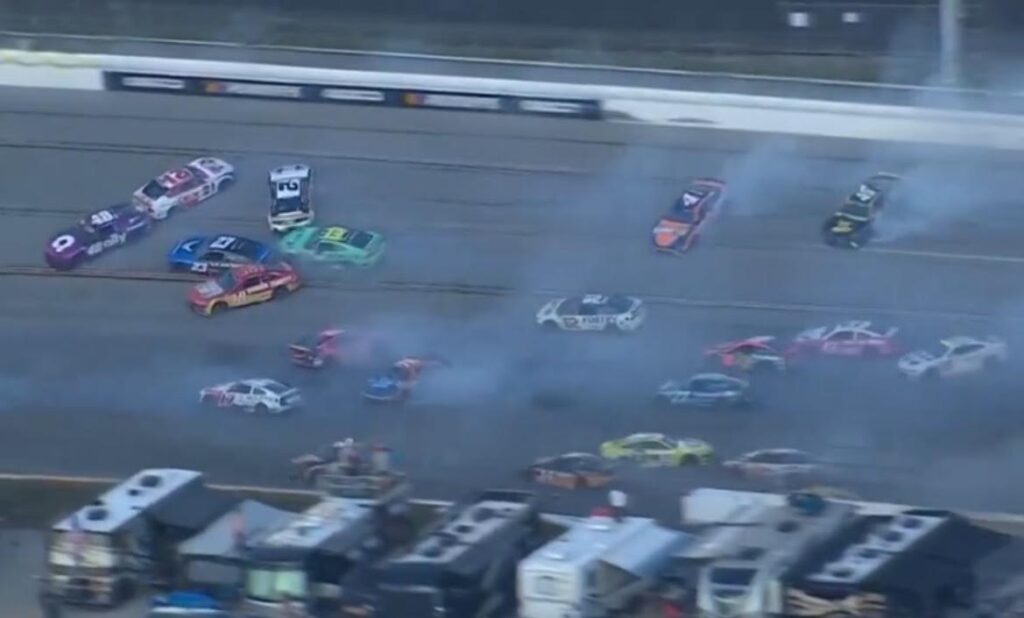On a dramatic Sunday afternoon at Talladega Speedway, NASCAR witnessed one of its largest crashes in history, involving a staggering 28 cars. This massive collision occurred with just five laps left in the race, dramatically altering the course of events and the fate of many drivers. The incident began when leader Austin Cindric was bumped by Joey Logano, who was several rows back. Logano’s push sent Cindric spinning, and as a result, a significant portion of the field was caught in the ensuing chaos, with 27 of the 40 cars sustaining some degree of damage. Fortunately, despite the scale of the crash, there were no reported injuries.
The aftermath of the crash was laden with frustration and scrutiny over NASCAR’s management of the challenging situation. As teams and personnel scrambled to assess the damage and clear the track, winning driver Ricky Stenhouse Jr. emerged victorious under contentious circumstances. Not only was Stenhouse’s car visibly damaged—with a clear chunk of sheet metal missing from the driver-side door—but his crew chief, Mike Kelly, pointed out discrepancies regarding safety measures taken in response to the wreck. Stenhouse, who would later confess to the presence of foam protruding from the hole in his car, became a focal point of post-race debate, raising questions about whether certain safety protocols were overlooked amid the tumult of the event.
In an attempt to manage the chaos, NASCAR officials red-flagged the race for nearly nine minutes to allow for cleanup and assessment of the situation. During this time, many teams were left to grapple with the implications of the crash—particularly how their cars would fare in the final two-lap overtime that followed. While 22 cars were able to remain on the lead lap, many were visibly damaged, setting the stage for a tense and unpredictable finish. The numerous damaged vehicles highlighted the severity of the crash while also adding an element of uncertainty to those who were still in contention for the win.
The glamorous speedway aura took a hit, as the once-exciting race devolved into discussions of safety and accountability. The thorough examination of how NASCAR handled the cleanup of such a monumental wreck led to concerns over whether officials prioritized race management over drivers’ safety. As multiple teams expressed their frustrations, it became clear that opinions varied greatly on the effectiveness of NASCAR protocols during emergencies. The sheer volume of cars involved raised questions about the pressing need for potential rule changes or heightened safety measures.
Despite the wreck and ensuing turmoil, the finale proved thrilling, with Stenhouse winning the race by a mere 0.006 seconds—a nail-biting finish that left fans on the edge of their seats. The intensity of the conclusion only added to the existing discourse surrounding the significant crash that had just unfolded. With all eyes on the remaining drivers and their battered vehicles, the event turned out not just to be a spectacle of speed but also an illustration of the sport’s inherent risks.
As the dust settled, NASCAR faced the challenge of addressing the implications of the crash while celebrating the excitement of the race. The incident will likely instigate further conversations regarding safety standards in the sport, especially the effectiveness of the NASCAR safety protocols in high-stakes situations like this one. As drivers and teams reflect on the day’s events, the focus shifts not only to the thrilling race results but also to the urgent need for improved safety measures in the future, ensuring that drivers can navigate the high-speed thrills of NASCAR racing with the security and protection they deserve.

